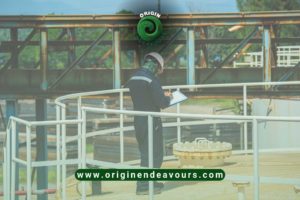Table of Contents

It is imperative to do aboveground storage tank inspections as soon as they are put into operation to keep them in good working order. It is important to maintain and inspect your equipment to prevent leaks, preserve your investment, and reduce costly repairs and environmental damage.
What is Aboveground Storage Tank?
An aboveground Storage Tank (AST) is a large, metal container that sits on the ground and holds a variety of liquids or gases for a short period of time. Anything from water to crude oil to various chemical products can be involved.
Aboveground storage tanks are subject to many standards, including API 653. All phases of tanks’ inspection, repair, alteration, and reconstruction are included in this class. The API Aboveground Storage Tank Inspection, Repair, Alteration, and Reconstruction Guidelines were developed to provide recommendations for inspecting, repairing, altering, and rebuilding aboveground storage tanks used in the petroleum and chemical industries. Prior to 2000, this was the sole standard for aboveground storage tanks. In addition to the many codes published by the Steel Tank Institute/Steel Plate Fabricators Association, which represents steel construction products such as storage tanks, water tanks, pressure vessels, pipes, and pipelines, and their suppliers, SP001 was published in 2000 and addresses welded metal, shop-built, and small field-erected tank inspections, among other things.
Why Aboveground Storage Tank Inspections Is Important?
It’s a fact that aboveground storage tanks are built to withstand the elements; however, one thing remains certain: If tanks are neglected, they will inevitably leak. Leaks are commonplace in tanks due to a variety of reasons, including faulty equipment, corrosion, and UV degradation. In addition to causing environmental contamination and workplace injuries, leaking tanks can be extremely hazardous. We provide comprehensive tank management services, providing maintenance guidelines, conducting routine inspections, and completing on-site cleanup for clients across the country.
How Frequently Do You Need to do Aboveground Storage Tank inspections?
The frequency of storage tank inspection must be determined taking into account several factors. API 653, 6.2.1 lists all the factors in order to explain how to calculate necessary storage tank volumes. Among other things, the list includes corrosion prevention and control systems, visual inspection results, and modifications in operational modes.
Generally, the following inspection intervals exist:
It is required that a Routine In-Service Inspection be performed every month, during which the external condition of the tank must be visually monitored by personnel knowledgeable about the facility, the tank, and the characteristics of the product stored.
- Stains: Make monthly visual inspections of the aboveground storage tanks looking for staining indicating leaks. Ensure that there is no product within the spill collection points or secondary containment.
- The Valves: Check for leaks, cracks, or corrosion on valves and pipes visually.
- The Foundations: Record any changes in the foundation from the last inspection in case there has been any deterioration, wash-out, settling, leaks, or other issues. It is important to maintain records over time in order to identify a pattern with tanks.
- Products Quantity & Type: Recordkeeping should include information about the quantity and type of products stored in the tank.
- The Internal: Periodically inspect the tank roof for corrosion, coating condition, and internal components, by opening the tank roof access.
An External aboveground storage tank Inspection must take place every 5 years, and an Ultrasonic Thickness Inspection of the shell must be included. According to API 653 Table 6.1, safeguards that extend the initial in-service date are the only ones that may be used 10 years after the tank’s initial in-service date.
Corrosion rates or RBI assessments can be determined using API 653 procedures based on data from the last Internal Inspection to determine subsequent Internal Inspection intervals.
Before the Internal Inspection, you should thoroughly clean your tank so that the tank’s internal components and structure can be examined. Product, water, and debris should be completely removed.
What Do We Cover During an Aboveground Storage Tank Inspection?
We’ll determine what type of aboveground storage tank inspection you require based on the tank’s contents. We provide a wide variety of services during our comprehensive aboveground storage tank inspections:
- Aperture
- Coating and liner
- Nozzle inspection
- Evaluation of settlement
- Strapping and calibration
- Roof inspection, including dome and seals
- Shell inspection
- Tank floor
Our tank inspectors will begin by examining your tank’s exterior to identify any cracks or flaws. If cracks are discovered, our inspector will estimate their magnitude and extent, and then proceed to additional testing. Our specialists will inspect the tank containment area to ensure there are no environmental hazards. Furthermore, our experts will search for any corrosion that might be eating away at the walls of your tank. Our inspectors will assess the damage and suggest how to make the tank meet code, even if leaks are discovered. If a tank has problems, it isn’t a catastrophe. Our remediation team can address any leaks within 24 hours of your inspection if needed.
Schedule Aboveground Storage Tank Inspections
Aboveground storage tanks are not without risk, and as the owner, you bear the ultimate responsibility. We at Origin endeavours are available to assist you in mitigating those risks if you desire. Contact us today!





